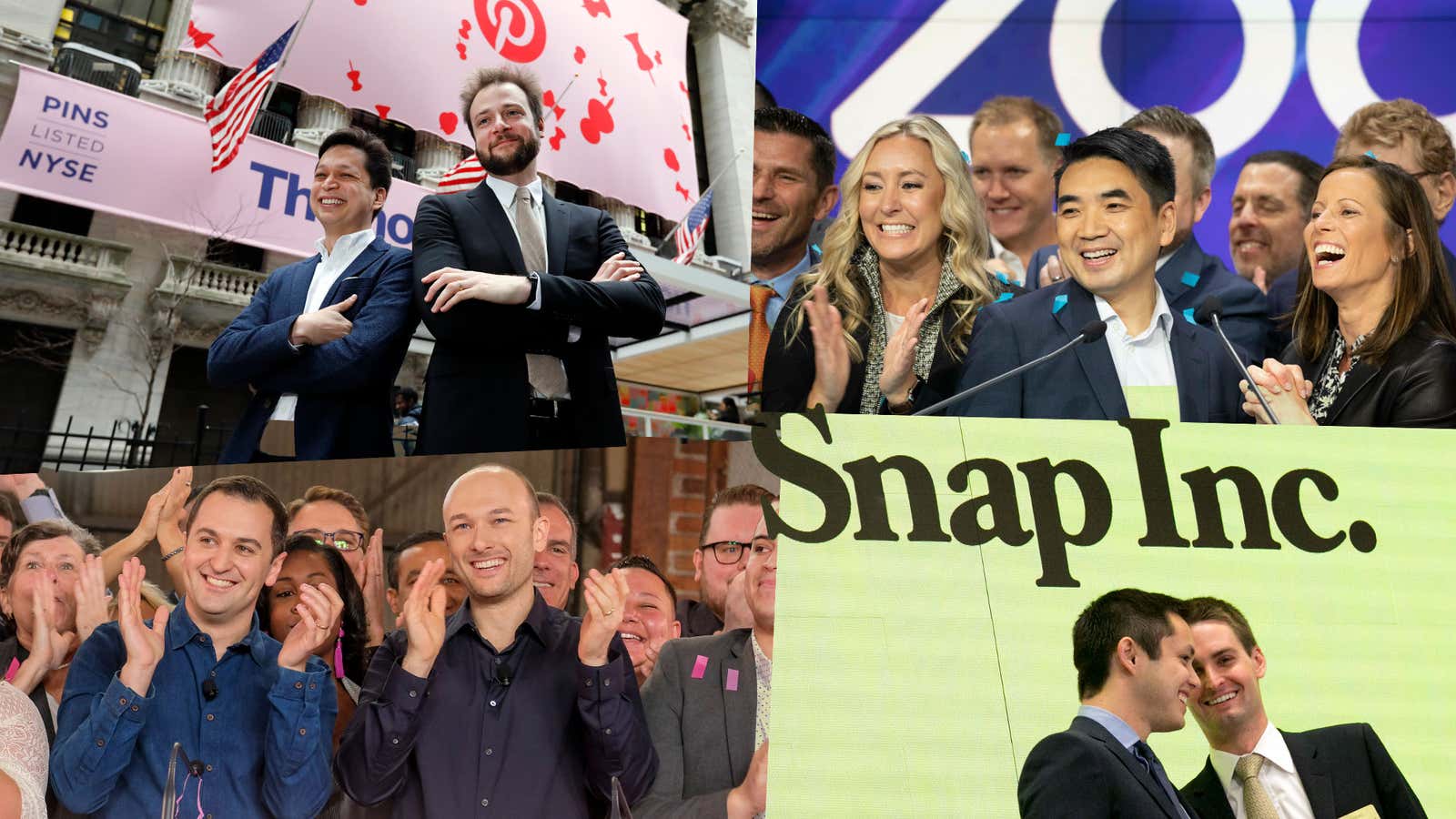Typically, an investor’s power over a company is proportional to the the amount of money they’ve invested: The more shares you own, the more votes you have to vote for members of the board or on governance proposals.
Large private companies pumped full of venture capital investment with sky-high valuations aren’t typical (as their moniker “unicorn” suggests). For example, Lyft founders Logan Green and John Zimmer own just 5% of their company’s shares but have 49% of the voting power. The company, which went public on March 29, accomplished this by creating a special class of stock reserved for the two founders. It comes with 20 votes per share. The regular class of stock that public investors can readily buy has one vote per share.
These special classes of stock with outsized voting right are often called “super-voting” shares.
Pinterest, also adopted a dual-class share structure: a super-voting class for certain insiders, and a regular-voting class for everyone else. Super-voting shares make up of 86% of the outstanding shares. The majority of those are held by venture capital firms that helped the company’s early growth. The two cofounders together have 13.4% of the voting power.
Because Pinterest’s super-voting shares automatically convert to low-vote shares when sold to the public, its founders’ voting power will grow much larger once the company’s original venture-capital funders start to sell their super-voting shares by virtue of reducing the denominator of any vote count.
The disproportional voting power the founders of Lyft and Pinterest possess isn’t anything new, at least not in the tech industry. Although the majority of US publicly traded companies—about 9 in 10—today have a one-share, one-vote structure, the dual-class structure has been increasingly adopted by tech companies 1.
When Google went public in 2004 with a dual-class structure, the company noted in its IPO filing that doing so “is unusual for technology companies.” It went on to say that the dual-class voting structure “is designed for stability over long time horizons” and “will enable us to retain many of the positive aspects of being private.”
The letter suggested that the founders would focus on the long-term interest of the company, while big investors snapping a sizable portion of the company might make short-sighted decisions that hurt the business. When Google restructured into a company called Alphabet Inc in 2014, it introduced a third class of stock with no voting rights. The new structure allowed its founders Larry Page and Sergey Brin to retain control of the company while owning a minority share of the stock.
Since Google’s IPO, many companies followed suit. Facebook adopted the dual-class structure in its 2012 IPO, giving Mark Zuckerberg absolute control of the company. By April 2019, Zuckerberg controlled 53% of the company’s voting power while holding only 13% of its outstanding shares. Dropbox, Eventbrite, Blue Apron, MongoDB, Roku, and Twilio all went public with shares granting certain holders 10 times the voting power as the shares available to the public. Snapchat parent Snap Inc went further when it listed in 2017. The shares it sold to the public came with zero votes.
Last week, Zoom went public with a one-to-10 dual-class structure. Slack is expected to do the same. Uber, however, bucks the trend, embracing just one class of stock.
Quartz picked a list of relatively well-known consumer-facing tech companies that went public with unequal voting rights, from the list compiled by Council of Institutional Investors. We analyzed their most recent proxy filings to understand the voting power of the founders. These companies vary in terms of how much stock they allocate for the publicly traded class, but in all cases, the key stakeholders—the founders, venture capitalists and family offices—are given outsized voting rights for relatively small equity holdings, thanks to the multi-class share structure.
For companies Quartz analyzed, the founders at the median company hold 19% of the total equity, and have 57% of the voting rights.
The institutional investors fight back
In 2016, Zuckerberg suggested splitting Facebook’s stock and creating a new non-voting class to ensure his control over the company while selling off his stock overtime. The plan didn’t go well with the investors and was eventually abandoned.
Major market indexes have also taken action against the approach after being pressured by institutional investors. In 2017, S&P Dow Jones Indices started to refuse adding new stocks to it’s flagship S&P 500 index that have multi-class share structures. FTSE Russell, in the same year, required new constituents of its indexes to have at least 5% voting rights in the hands of public shareholders.
Investors are petitioning major stock exchanges to require existing multi-class public companies to adopt a “sunset” provision that schedules shares in the super-voting class to be converted to the public class over time. Both Pinterest and Zoom included the provisions. Pinterest set its super-voting shares to be automatically converted to the public shares over seven years, and Zoom set a 15-year restraint. Research conducted by the US Securities and Exchange Commission shows that companies that sunset their multi-class structures outperform those that don’t in the long term.
The institutional investors may also act in their own interest. Lise Buyer, an adviser to companies pursuing IPOs, told the Wall Street Journal that the structure can be appropriate for certain company founders who may face pressure to make decisions to boost short-term profits at the expense of long-term goals.
